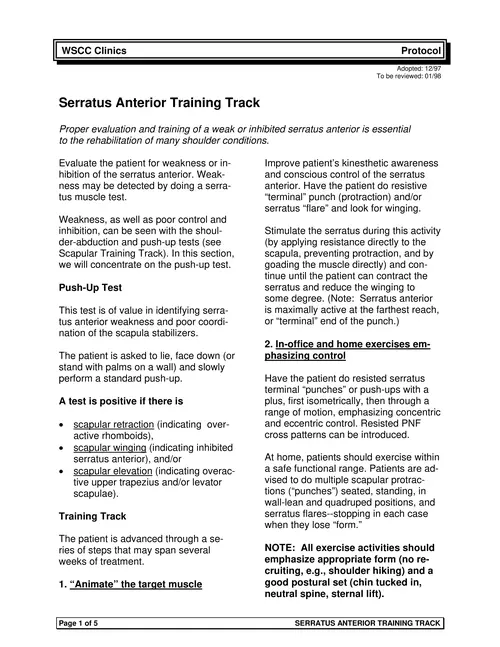
Serratus Anterior Training Track - Wing FTP Server
(Note: Serratus anterior is maximally active at the farthest reach, or ?terminal? end of the punch.) 2. In-office and home exercises em- phasizing control.
adsPart of the document
WSCC Clinics
Protocol
Adopted: 12/97
To be reviewed: 01/98
Serratus Anterior Training Track
Proper evaluation and training of a weak or inhibited serratus anterior is essential
to the rehabilitation of many shoulder conditions.
Evaluate the patient for weakness or in-
hibition of the serratus anterior. Weak-
ness may be detected by doing a serra-
tus muscle test.
Weakness, as well as poor control and
inhibition, can be seen with the shoul-
der-abduction and push-up tests (see
Scapular Training Track). In this section,
we will concentrate on the push-up test.
Push-Up Test
This test is of value in identifying serra-
tus anterior weakness and poor coordi-
nation of the scapula stabilizers.
The patient is asked to lie, face down (or
stand with palms on a wall) and slowly
perform a standard push-up.
A test is positive if
there is
scapular retraction (indicating over-
active rhomboids),
scapular winging (indicating inhibited
serratus anterior), and/or
scapular elevation (indicating overac-
tive upper trapezius and/or levator
scapulae).
Training Track
The patient is advanced through a se-
ries of steps that may span several
weeks of treatment.
1. "Animate" the target muscle
Improve patient's kinesthetic awareness
and conscious control of the serratus
anterior. Have the patient do resistive
"terminal" punch (protraction) and/or
serratus "flare" and look for winging.
Stimulate the serratus during this activity
(by applying resistance directly to the
scapula, preventing protraction, and by
goading the muscle directly) and con-
tinue until the patient can contract the
serratus and reduce the winging to
some degree. (Note: Serratus anterior
is maximally active at the farthest reach,
or "terminal" end of the punch.)
2. In-office and home exercises em-phasizing control
Have the patient do resisted serratus
terminal "punches" or push-ups with a
plus, first isometrically, then through a
range of motion, emphasizing concentric
and eccentric control. Resisted PNF
cross patterns can be introduced.


